
Paradoris dubia
(Bergh, 1904)
Order: NUDIBRANCHIA
Suborder: DORIDINA
Superfamily: EUDORIDOIDEA
Family: Discodorididae
DISTRIBUTION
Southern Australian waters from sthn New South Wales, Tasmania, Victoria, South Australia and sthn Western Australia.
PHOTO
Locality: Bluff Beach, Yorke Peninsula, South Australia. intertidal under rocks. 23 February 1985. 4 specimens 14, 24, 28, 31 mm long alive. AM C145212. Photos: Bill Rudman.
The mantle is translucent white with varying amounts of brown pigmentation, some animals being very pale while others are dark brown. Scattered over the dorsum are greyish brown blotches some of which encircle a ring of white glands, which themselves surround a low rounded pustule. These glandular structures are very characteristic of this species and greatly vary in number, some animals, like those figured here, have many scattered over the dorsum, while other animals have just a few down each side of the mantle skirt.
There are 7-9 tripinnate gills. They are transparent with brown speckling, and when extended are relatively small for the size of the animal. The rhinophore clubs are dark brown or black. The underside of the mantle, the sides and sole of the foot are translucent whitish with scattered dark brown specks. The brown speckling is very variable, some specimens having almost none while others have many.
In my field notes I describe this species as looking like lumps of white sponge on intertidal rocks. When disturbed a milky secretion is exuded from the glands on the dorsum. It is a relatively small dorid reaching about 35 mm in length alive. There are no easy external characteristics to show it belongs in the genus Paradoris. One that can be seen is a groove along the outer side of the oral tentacles.
Like many of the 'flat' nondescript dorids, this species has had a confused nomenclatural history. Described from preserved specimens from northern Tasmania (Bergh, 1904) later workers were not aware that this species possessed such distinctive mantle glands. Bergh placed this species in the genus Discodoris, and most subsequent reports list it as Discodoris dubia, but Basedow & Hedley (1905) and Burn (1957) misidentified as Alloiodoris marmorata Bergh, 1904 - a quite different species. In Dayrat's recent review (2006), he also considers Discodoris? egena Bergh, 1904; Alloiodoris nivosus Burn, 1958; and Paradoris leuca Miller, 1995 to be synonyms. While I agree with his first two synonymies, I think there is as yet too little information available on the living New Zealand species, Paradoris leuca, to be sure its just a colour variant.
- Basedow, H. & Hedley, C. 1905. South Australian nudibranchs, and an enumeration of the known Australian species. Transactions of the Royal Society of South Australia 29: 134-160.
- Bergh, L.S.R. (1904) Malacologische Untersuchungen. In: C.G. Semper, Reisen im Archipel der Philippinen, Wissenschaftliche Resultate. Band 9. Lief 1: 1-56, Pls. 1-4.
- Burn, R.F. (1957) On some opisthobranchia from Victoria. J. Mal. Soc. Aust. 1, 11-29, Pls1-3.
- Burn, R.F. (1958) Further Victorian Opisthobranchia. J. Mal. Soc. Aust. 2, 20-36. (pls. 6-7)
- Dayrat, B. (2006) A taxonomic revision of Paradoris sea slugs (Mollusca, Gastropoda, Nudibranchia, Doridina). Zoological Journal of the Linnean Society, 147 (2): 125-238.
Rudman, W.B., 2007 (January 10) Paradoris dubia (Bergh, 1904). [In] Sea Slug Forum. Australian Museum, Sydney. Available from http://www.seaslugforum.net/find/paradubi
Related messages
Paradoris from New Zealand
January 12, 2010
From: Nova Mieszkowska
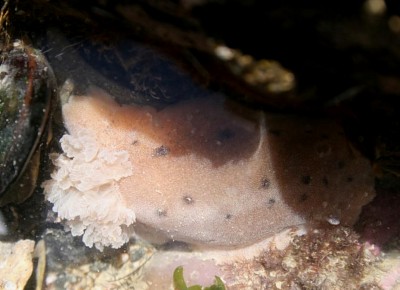
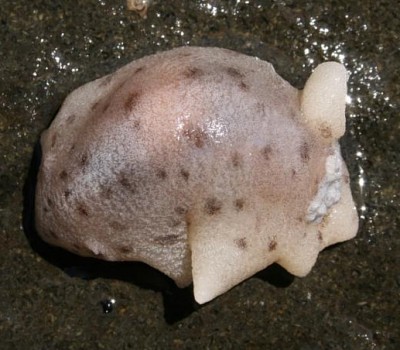
Hi
Please can you tell me what species this is? I took it on the rocky intertidal at Timaru, on the east coast of the South Island of New Zealand. I have seen several individuals at shores on both islands so I am assuming that they are relatively common.
Locality: Timaru, on the east coast of the South Island of New Zealand, 44.3774 S, 171.2497 E., 10 January 2008, Intertidal rock. Length: ~ 2 inches. Photographer: N Mieszkowska.
Many thanks
Nova Mieszkowska
nova@mba.ac.uk
Mieszkowska, N., 2010 (Jan 12) Paradoris from New Zealand. [Message in] Sea Slug Forum. Australian Museum, Sydney. Available from http://www.seaslugforum.net/find/23082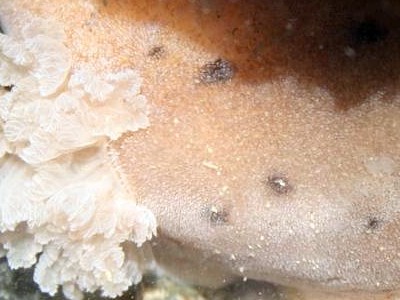
Dear Nova,
This is a nice find because it sorts out a taxonomic puzzle. I am sure your animal is a species of Paradoris. This genus was revised recently (Dayrat, 2006) and he considered that the only species known from New Zealand, Paradoris leuca Miller, 1995 was the same as Paradoris dubia which is a fairly common species in southern Australia. However most specimens of P. dubia, which I am familiar with, have distinctive brownish glands on the mantle, and these brown patches have never been recorded from the few known New Zealand specimens. So until now I have tentatively left P. leuca as a good species [see also message #18265]. However your animal clearly shows the brown patches, so unless both species occur in New Zealand I am pretty sure we should be calling this New Zealand animal Paradoris dubia.
- Dayrat, B. (2006) A taxonomic revision of Paradoris sea slugs (Mollusca, Gastropoda, Nudibranchia, Doridina). Zoological Journal of the Linnean Society, 147 (2): 125-238.
- Miller, M. C. (1995) New species of the dorid nudibranch genus Paradoris Bergh, 1884 (Gastropoda: Opisthobranchia). Journal of Natural History 29: 901-908.
Best wishes,
Bill Rudman
Paradoris dubia and egg ribbon
August 20, 2007
From: Bruce Potter
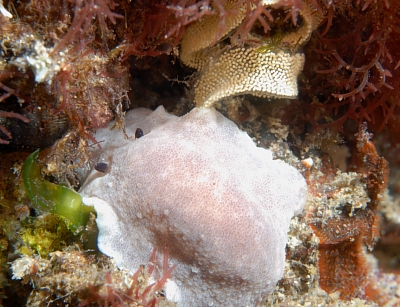
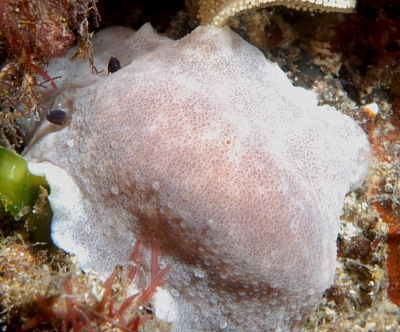
Dear Bill,
I spotted this Paradoris dubia up under some weeds and in trying to move the weeds aside I bumbed the nudi loose from its position. I then saw that it was laying eggs. So the egg ribbon should be a circle, not stretched out like this, but thought it might be of interest anyway.
Locality: Rockingham, 3 metres, Western Australia, Indian Ocean, 11 August 2007, Mucky under Jetty. Length: 20 mm. Photographer: Bruce Potter.
Regards
Bruce Potter.
bandppotter@bigpond.com
Potter, B., 2007 (Aug 20) Paradoris dubia and egg ribbon. [Message in] Sea Slug Forum. Australian Museum, Sydney. Available from http://www.seaslugforum.net/find/20477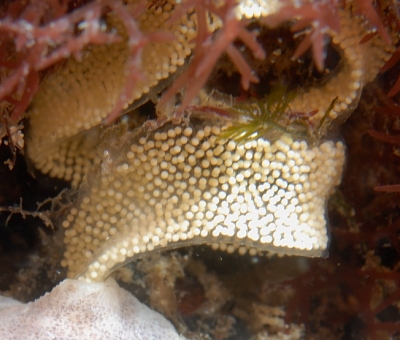
Dear Bruce,
I am so glad you thought it worth photographing the egg ribbon - if a bit dishevelled. To my recollection this is the first information we have on the eggs of this species. From your photo, the eggs look relatively large, which could suggest that the larvae are not planktotrophic veligers, swimming and feeding in the plankton for some weeks, but either lecithotrophic, with a short non-feeding larval life, or hatching directly as minute crawling slugs.
Best wishes,
Bill Rudman
Paradoris dubia from New South Wales
June 26, 2007
From: Leanne & David Atkinson
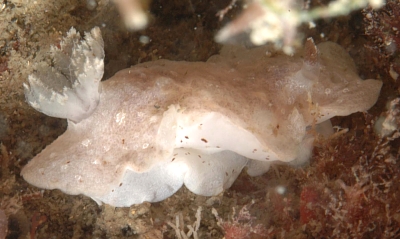
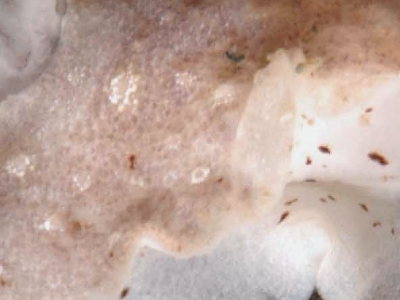
Concerning message #19604:
Dear Bill,
Nerida Wilson's sharp eyes found this nudibranch at the Pipeline. The characteristics that struck us the most were the white circles on the body, some like a child's drawing of a sun with spokes, and the brown spots on the side of the foot. Once Nerida saw the photos she suggested it might be a pale Paradoris dubia. The circles fit with your description of the glands but the rhinophores seem a little pale in comparison to the specimens on the fact sheet. There is one previous message with paler rhinophores similar to this one. It is the first time we have seen this in the Port Stephens area.
Locality: The Pipeline, Port Stephens, 8 metres, New South Wales, Australia, Pacific, 12 April 2007, Silty sand, scattered sponges, ascidians and soft corals. Length: 30 mm approximately. Photographer: Leanne & David Atkinson.
Can you confirm its identity?
Thanks for your help,
Leanne & David Atkinson
atk@hunterlink.net.au
Atkinson, L. & D., 2007 (Jun 26) Paradoris dubia from New South Wales. [Message in] Sea Slug Forum. Australian Museum, Sydney. Available from http://www.seaslugforum.net/find/20004
Dear Leanne & David,
Your description of 'a child's drawing of a sun with spokes' fits my drawing [message #19148] of these glands. I am sure your animal is Paradoris dubia which takes it a bit further up the east coast than it has been reported before.
Best wishes,
Bill Rudman
Paradoris dubia from Western Australia
April 18, 2007
From: Bruce Potter
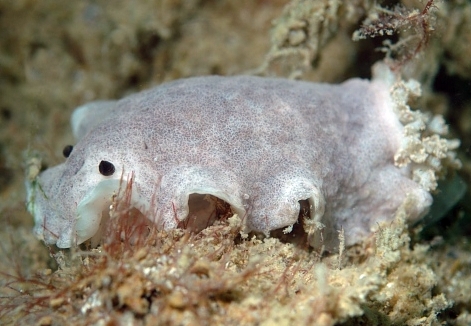
Dear Bill,
I was not sure about this one to begin with, but have decided it is Discodoris dubia It was under the small jetty a Rockingham quite near a Dendrodoris nigra, making an interesting contrast between the white and black.
It was about 30mm long and at 6 metres deep.
Locality: Rockingham, 6 metres, Western Australia, Indian Ocean, 24 February 2007, Mucky under Jetty. Length: 30mm. Photographer: Bruce Potter.
Regards
Bruce Potter.
bandppotter@bigpond.com
Potter, B., 2007 (Apr 18) Paradoris dubia from Western Australia. [Message in] Sea Slug Forum. Australian Museum, Sydney. Available from http://www.seaslugforum.net/find/19604Dear Bruce,
Yes this seems to be what was called Discodoris dubia and is now Paradoris dubia. Have a look at the species Fact Sheet and associated messages for background information. It's nice to get a western example of the species.
Best wishes,
Bill Rudman
Could this be Discodoris lilacina
January 11, 2007
From: Dennis Hutson

Hi Bill,
I found this little creature on a recent dive. The location was just out from the boat ramp of our shipping channel leading into the Port River. This area is known as Outer Harbour. Local waters of Gulf St. Vincent, South Australia. I photographed this nudibranch and after consulting Neville Coleman's book "1001 Nudibranchs", I thought it might be Discodoris lilacina. I am only able to go by basic visual characteristics. Is this critter local to my waters?
Locality: Outer Harbour, Adelaide. Depth: 4 metres. South Australia. Length: 40 mm. 20 August 2005. Silty bottom. Photographer: Dennis Hutson
Thanks for your continued support.
Cheers
D.
dghutson@ozemail.com.au
Hutson D.G., 2007 (Jan 11) Could this be Discodoris lilacina. [Message in] Sea Slug Forum. Australian Museum, Sydney. Available from http://www.seaslugforum.net/find/14611Dear Dennis,
I am too embarassed to say how long this message has been waiting from me to prepare a Fact Sheet on Paradoris dubia. My apologies. Your animal looks like a Discodoris, and in fact has been placed in that genus until Benoit Dayrat's recent revision of the genus Paradoris. As you may have guessed by now, your animal is Paradoris dubia. It usually has ring-shaped marks on the mantle which are quite distinctive. I have posted a Fact Sheet today. Have a look at that and the accompanying messages I am also posting to show colour variability.
Best wishes,
Bill Rudman
Paradoris dubia from southern New South Wales
January 11, 2007
From: Bill Rudman
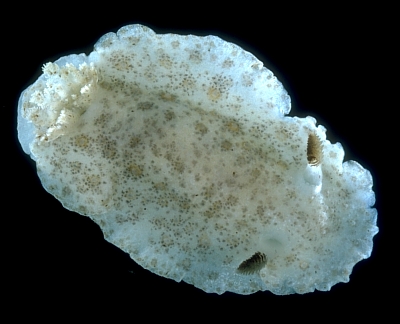
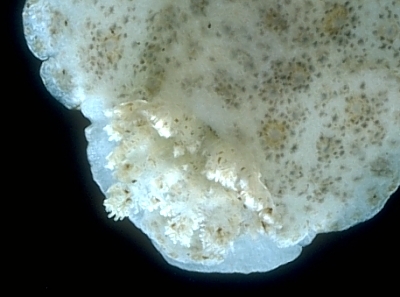
Paradoris dubia is usually found in southern Australian waters, from Bass Strait across to Western Australia. It is rarely found up the east coast. Here is a rare example from Eden, in southern New South Wales.
Locality: Bitangabee Bay, Eden, southern New South Wales, Australia. intertidal under rock. 25 February 1983. 17 mm long alive. AM C137991. Photo: Bill Rudman.
Best wishes
Bill Rudman
Paradoris dubia from Tasmania, Australia
January 11, 2007
From: Bill Rudman
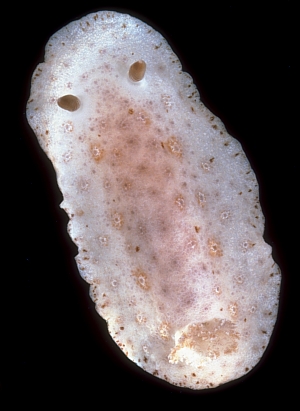
I have included this photo of Paradoris dubia from Ulverstone, Tasmania, as it is from the spot that Miss Lodder probably made the collections which were sent to Bergh (1904) for examination and description as a new species. Bergh's type material is lost. The specimens in my collection ranged from dark brown to this pale white colour.
Locality: Picnic Point, Ulverstone, nthwest coast Tasmania, Australia. intertidal. 21 February 1984. 5 specimens 15 - 27 mm long alive. AM C141292. Photo: Bill Rudman.
Best wishes
Bill Rudman
Paradoris dubia from Yorke Peninsula, SA
January 11, 2007
From: Bill Rudman
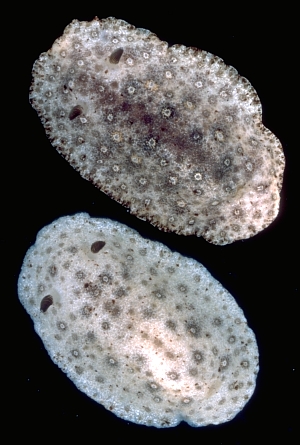
Here are two specimens of Paradoris dubia from Yorke Peninsula, South Australia, showing the range in background colour from white to dark brown. These animals also show the ringed glands very clearly.
Locality: Bluff Beach, Yorke Peninsula, South Australia. intertidal under rocks. 23 February 1985. 4 specimens 14, 24, 28, 31 mm long alive. AM C145212. Photos: Bill Rudman.
Best wishes
Bill Rudman
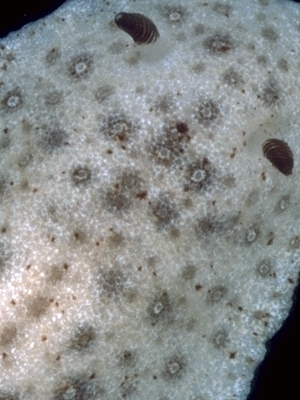
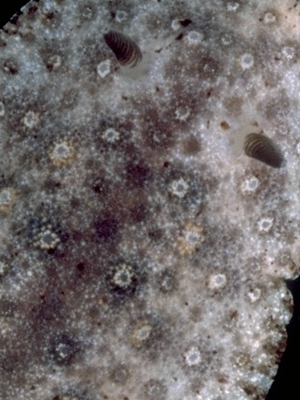
Paradoris dubia from Eyre Peninsula [2]
January 11, 2007
From: Bill Rudman
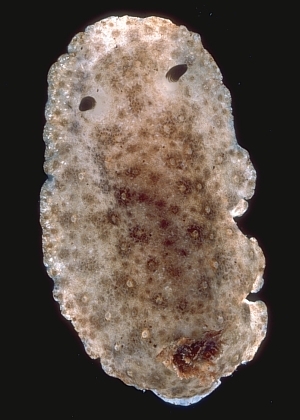
Here is another example of Paradoris dubia from South Australia. This one shows the scattered glandular pustules very well. As I show in the sketch of a living animal from my field notes, each rounded pustule is surrounded by two rings of glands which radiate out from the pustule. The inner glands are short, usually opaque and very close to the surface of the skin. The longer outer glands are more deeply embedded in the skin and often not noticeable except through a microscope. These glands exude a milky white secretion when irritated. The inner glands can sometimes be covered with a fine dusting of orange brown specks so that each compound gland can consist of a brownish inner ring and a grey outer ring
Locality: Billy Light's Point, Port Lincoln, Eyre Peninsula, South Australia. intertidal, under rock. 15 December 1985. 5 specimens ranging in length from 21 - 28 mm alive. AM C145149. Photo: Bill Rudman
Best wishes
Bill Rudman
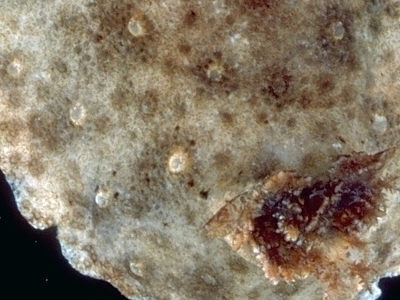
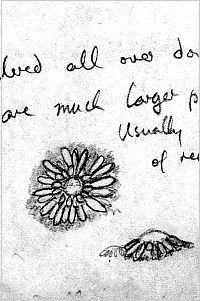
Paradoris dubia from Eyre Peninsula [1]
January 11, 2007
From: Bill Rudman
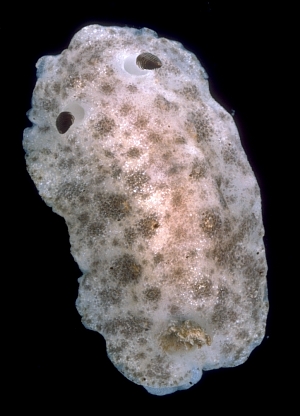
Here are photos of 3 specimens of Paradoris dubia from intertidal collections at Louth Bay, Eyre Peninsula. They were collected on a month long field trip I did with Ian Loch and Geoff Avern to South Australia. From memory it was the day after someone had been killed by a Great White Shark in the next bay and we thought that even intertidal collecting was quite brave at the time.
Location: Warna Point, Louth Bay, Eyre Peninsula, South Australia. intertidal, under mid-tidal rocks. 11 February 1985. 11 specimens ranging in length from 31 - 12 mm alive. Photographed specimens approximately 25 mm long. AM C145110. Photos: Bill Rudman
These photos show the range of colour variation in the species. One constant feature which I will discuss in a separate message are the grayish rings which surround a slightly raised pustule.
Best wishes
Bill Rudman
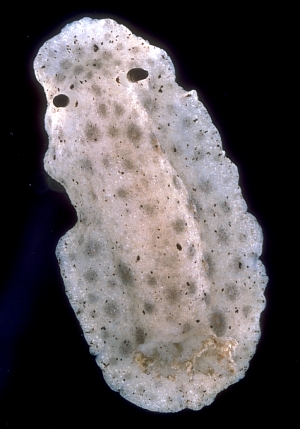
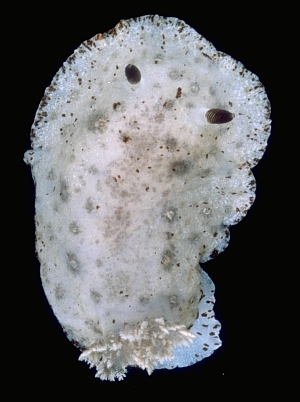
Paradoris dubia and P. leuca
January 11, 2007
From: Bill Rudman
I recently noted Benoit Dayrat's comprehensive revision of the genus Paradoris [message #18271] when I was posting an inquiry about an animal from New Zealand that I identified as Paradoris leuca [message #18265 ]. In that message I noted I was unsure about Benoit's proposal to consider the New Zealand P. leuca to be a synonym of the southern Australian Paradoris dubia. All specimens of P. dubia which I have seen have a very distinctive pattern of dark rings on the mantle which surround compound glands. The only two photos of Paradoris leuca that I know of [both on the Forum] show no sign of these dark rings or the associated glands.
This is a genus in which there are few gross anatomical differences between species, so it seems to me that we should wait until more material of the New Zealand species is examined before we consider them to be a single species. I have been planning for some time to post a selection of photos of Australian specimens of P. dubia on the Forum and am at last able to say I have found the time. So as you will see by the many messages, today is almost exclusively a Paradoris dubia day
Best wishes
Bill Rudman
Paradoris leuca from Moeraki, South Island, New Zealand
November 10, 2006
From: Kimberley Seaward
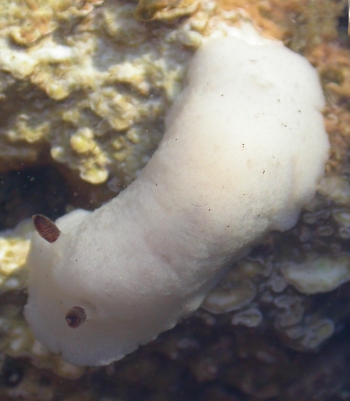
Dear Bill,
Here is a photo of a nudibranch I took on my recent trip to Moeraki. It was relatively abundant, although I haven't even started to look to find out what it is
Locality: Moeraki, Otago, South Island, New Zealand, east coast. Intertidal. 02 November 2006, Intertidal . Length: approx 3 cm. Photographer: Kimberley Seaward.
Thanks,
Kimberley
kimberley.seaward@canterbury.ac.nz
Seaward, K.J., 2006 (Nov 10) Paradoris leuca from Moeraki, South Island, New Zealand. [Message in] Sea Slug Forum. Australian Museum, Sydney. Available from http://www.seaslugforum.net/find/18265Note added 12 January 2010: I have posted a message today showing a specimen of Paradoris from New Zealand with the characteristic brown marks of P. dubia whch suggests Dayrat's synonymy of P. leuca with P. dubia is correct. See message #23082
Dear Kimberley,
This is an interesting find. This dorid is Paradoris leuca Miller, 1995, which was only described from New Zealand ten years ago. Apart from its anatomical features, the main external character is its white mantle and brown rhinophores. I have posted a page on this species today which includes a photo kindly provided by Michael Miller of a specimen he photographed from Portobello, Dunedin, New Zealand, and formed part of his description. The genus Paradoris has only just been revised (Dayrat, 2006), and in that paper it is suggested that P. leuca is a synonym of the southern Australian species, Paradoris dubia (Bergh, 1904), but I have my doubts. The colour photos I have seen of the New Zealand animals seem to lack the colour patterning found in Australian P. dubia. As Benoit notes in his revision, we know so little about the colour of most species of this genus that synonymising these species at present would seem a bit premature.
-
Dayrat, B. (2006) A taxonomic revision of Paradoris sea slugs (Mollusca, Gastropoda, Nudibranchia, Doridina). Zoological Journal of the Linnean Society, 147(2): 125-238.
-
Miller, M. C. (1995) New species of the dorid nudibranch genus Paradoris Bergh, 1884 (Gastropoda: Opisthobranchia). Journal of Natural History 29: 901-908.
Best wishes,
Bill Rudman
Revision of the dorid genus Paradoris
November 10, 2006
From: Bill Rudman
Benoit Dayrat has recently published a major revision of the little-known dorid genus, Paradoris Bergh, 1884. I will try and make the necessary chnages on the Forum in the next few weeks.
Paradoris, has traditionally been considered a genus of the Discodorididae. This is the first comprehensive revision of the genus. One hundred and thirty specimens were examined, including all types and most of the nontype specimens available. New records for Paradoris are provided: South Africa, Tanzania, Seychelles, Western Australia, Thailand, Philippines, shallow waters of New Caledonia, southern Japan, and Hawaii. Prior to this revision, Paradoris included 15 nominal species: 12 valid names and three synonyms. Three additional names, Discodoris erythraeensis, D. lora, and D. cavernae, are re-allocated to Paradoris, based on phylogenetic analysis. A phylogenetic diagnosis is provided for Paradoris: in particular, two new synapomorphies are described. Eight species names are regarded as valid: P. araneosa, P. dubia, P. erythraeensis, P. indecora, P. liturata, P. lopezi, P. mulciber, and P. tsurugensis. However, most of these species are poorly known, i.e. from very few specimens, and their taxonomic status might change when more individuals are available. P. lora is regarded as a nomen dubium. Six new synonymies are proposed and three new 'morphospecies' are described, but not formally named because their taxonomic status is still uncertain for several reasons (e.g. lack of knowledge of individual variation for some critical features).
- Dayrat, B. (2006) A taxonomic revision of Paradoris sea slugs (Mollusca, Gastropoda, Nudibranchia, Doridina). Zoological Journal of the Linnean Society, 147(2): 125-238.
Bill Rudman
Rudman, W.B., 2006 (Nov 10) Revision of the dorid genus Paradoris. [Message in] Sea Slug Forum. Australian Museum, Sydney. Available from http://www.seaslugforum.net/find/18271